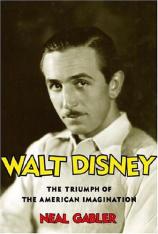Walt Disney: The Triumph of the American Imagination
Review
Walt Disney: The Triumph of the American Imagination
There's a song Jews sing around the Passover Seder table each year
that says, in essence, if God had done just one thing, instead of
the many miracles, involved in freeing them from Pharaoh's bondage,
it would have been enough.
At the risk of appearing blasphemous in paraphrasing, if Walt
Disney had just invented Mickey Mouse, it would have been enough;
if he had just created Snow White, or Bambi, or any
of the many other family-friendly films for which the Disney name
has become synonymous, it would have been enough; or if he had
designed and constructed his theme parks, it would have been
enough.
But Disney did it all, and for that people loved him because he
created a world they wanted, real or imagined.
Neal Gabler's exhaustive biography of one of America's iconic
figures follows his subject from a humble Missouri childhood to his
(relatively) sudden death at age 65. In the interim, Disney became
eponymous with family entertainment.
After getting his feet wet with early animation in Alice's
Wonderland, Disney and his retinue developed Oswald, the Lucky
Rabbit, a precursor to the beloved Mouse (for which he won an Oscar
in 1932). The rodent soon turned out to be a cottage industry and
paved the way for more ambitious projects, beginning with what was
originally called "Disney's Folly."
Snow White, the first full-length animated movie, was a
window into Disney's psyche, according to Gabler. It had "nearly
all the narrative features --- the tyrannical parent, the sentence
of drudgery, the promise of childhood utopia --- and incorporated
nearly all the major themes of his young life." The author
maintains that Disney had a fairly miserable childhood, including
holding various --- but not atypical --- boyhood occupations such
as delivering newspapers, as well as a father portrayed as
humorless and demanding. But such rationalizations don't mesh. For
all the cited examples, Disney's childhood, although not in the
realm of a silver spoon upbringing, does not seem excessively harsh
for his generation.
Snow White received acclaim from both critics and audiences
and was followed by Pinocchio and the ambitious
Fantasia (which was not box office gold). Subsequent movies
were well-received for the most part, and Disney was soon looking
for other avenues on which to expend his almost limitless energy,
including forays into television with "The Mickey Mouse Club" and
"Davey Crockett" and the eponymous Disneyland, all of which are
chronicled in painstaking detail.
As has become the norm, by dint of the book's breadth, the author
wants the reader to appreciate how much research he has done in
pursuit of understanding his subject, and for this Gabler indeed
deserves praise.
On the other hand, I wonder how much the reader really cares about
the payroll and other expenditures of Disney's salad days. Indeed,
the majority of the book seems to consider Disney's day-to-day
business dealings as much as, if not more than, his personal life.
Out of necessity, given Disney's role, most of the narrative takes
place "behind the scenes," much of it devoted to business dealings.
Like Macy's vs. Gimbel's, the competition among animation studios
was fierce, with constant raids of rivals' artistic "stables";
there was always some economic, scheduling or personnel crisis
going on.
It almost seems curmudgeonly to speak ill of a book about such an
outwardly beloved personality as Walt Disney, but for all the
narrative in his 600-plus pages, Gabler spends little time
explaining the whys of his subject. Why a mouse --- normally
perceived as a repulsive creature --- as Disney's signature
character? How did it evolve from its primitive stages to today's
instantly recognizable cartoon? Perhaps someone will cover that in
a subsequent volume.
Reviewed by Ron Kaplan on January 24, 2011
Walt Disney: The Triumph of the American Imagination
- Publication Date: October 31, 2006
- Genres: Biography, Nonfiction
- Hardcover: 880 pages
- Publisher: Knopf
- ISBN-10: 0679438229
- ISBN-13: 9780679438229



